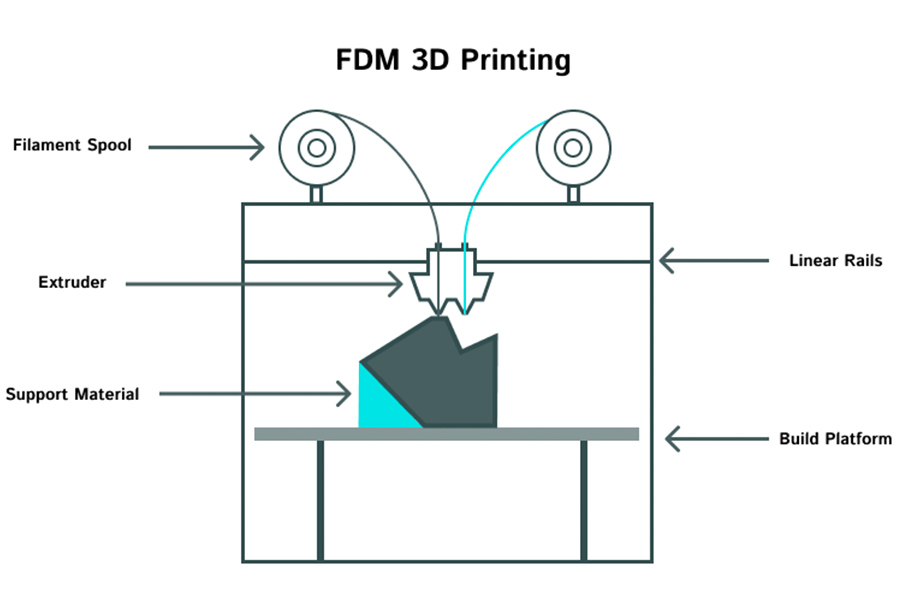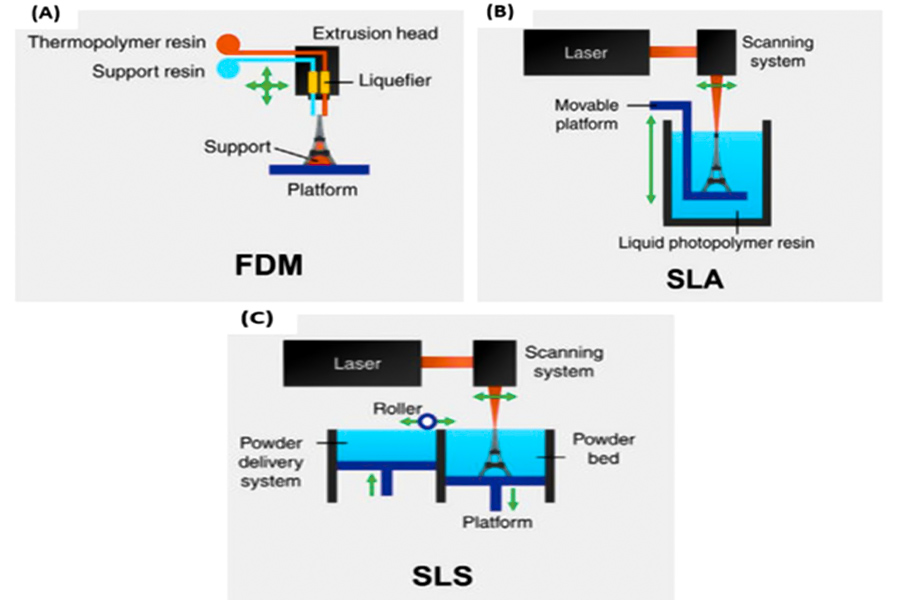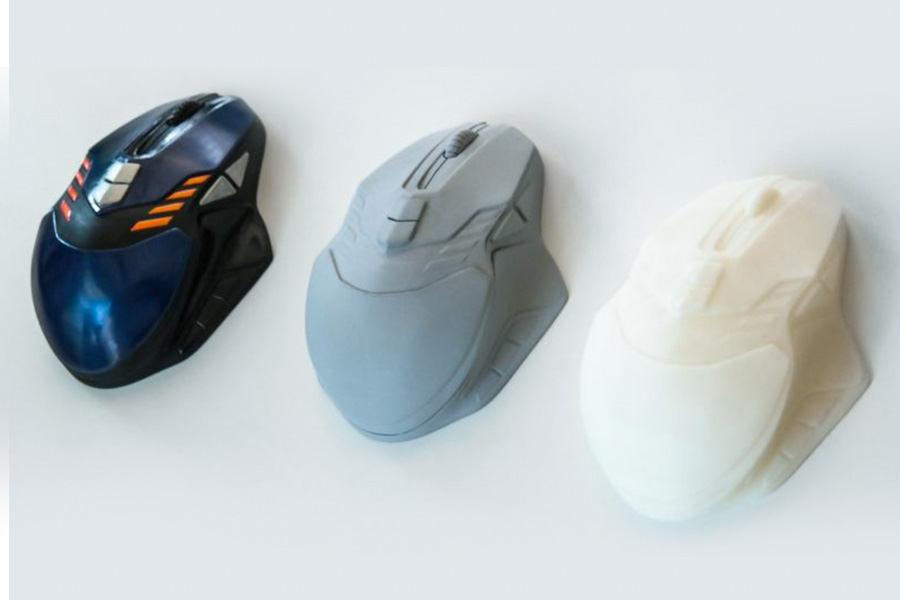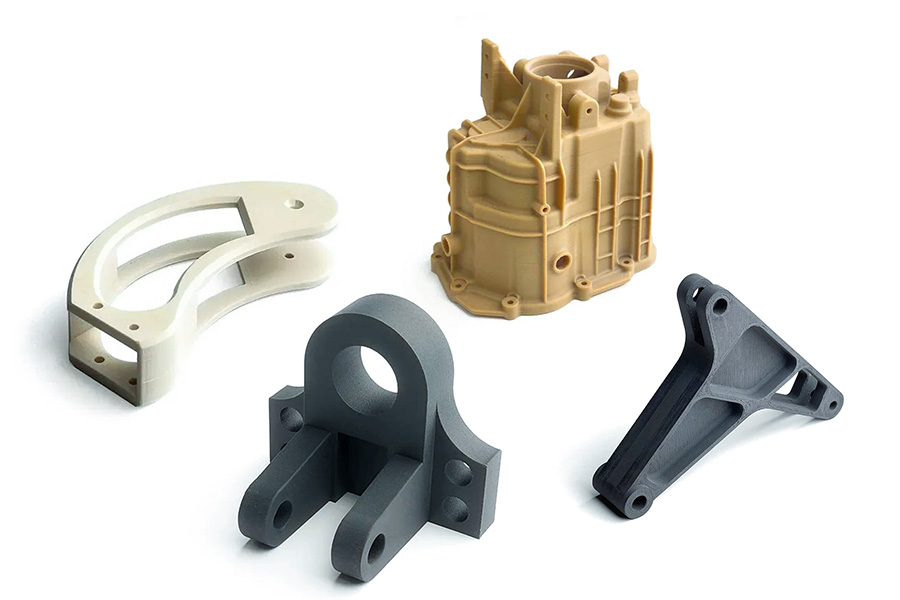Fused Deposition Modeling - FDM 3D printing technology, also known as Fused Filament Manufacturing - FFF 3D printing technology, is one of the most popular additive manufacturing technologies. It is by far the most popular and widespread3D printing technologyin the world.
This technology emerged in 2004 and has been popularized in various fields since then, and its applications have also covered various fields.
Here we will explain through this article what exactly is this technology?
What is fused deposition modeling?
FDM 3D printers are often the first step into the world of 3D printing for many people. In design, engineering, and manufacturing, it is often used as a tool to quickly validate concept models and help design teams reach consensus before further developing functional prototypes.
There are many types of FDM 3D printers, with different sizes and prices. The simplicity of its printing technology and workflow makes it an ideal choice for those new to the field of 3D printing, without too much investment to get started. However, it’s worth noting that FDM printers often compromise in their pursuit of part quality and performance. For those users who have higher requirements for functional performance, water resistance, isotropic or smooth surfaces, SLA and SLS 3D printers may be a better choice.

How Does FDM 3D Printing Work?
One of the reasons why fused deposition modeling is one of the most common 3D printing technologies is the simplicity of the process. The FDM process can be divided into the following steps.
Step 1: CAD Design
The first step is the design process, which involves creating a 3D digital model using computer-aided design (CAD) software. The design process outlines the size and shape of the 3D printed product.
Step 2: Slice
Once the CAD design is complete, specialized software is used to slice the 3D model into thin layers. Each layer is then converted into code that instructs the 3D printer on how to deposit the material.
Step 3: Liquefy
The sliced CAD design is sent to an FDM 3D printer, where a solid building filament material (usually acrylonitrile butadiene styrene or polylactic acid) is heated to the point of liquefaction in a liquefier head.
What Are the Advantages of FDM?
The advantages of fused deposition modeling (FDM) are mainly reflected in the following aspects:
- Low cost:The equipment is relatively affordable and the material cost is low, making it suitable for mass consumption and wide application.
Easy to operate: mature technology, easy for users to use, suitable for families, schools and small studios. - Diverse materials:Supports a variety of thermoplastic materials, such as PLA, ABS, etc., and you can choose the appropriate material according to your needs.
- Environmentally friendly:Using non-toxic or low-toxic materials, it has little impact on the environment and human health.
- Support structure is easy to design:When a support structure is required, it is relatively simple to design and easy to remove.
- Flexible printing size:The printing size can be adjusted according to needs to adapt to different application scenarios.
What Are the Limitations of FDM?
The disadvantages of fused deposition modeling (FDM) mainly include the following aspects:
- Limited accuracy:Limited by nozzle diameter and layer thickness, printing accuracy is relatively low.
- Requires support structures:When printing complex or suspended structures, it is usually necessary to add support structures, which increases the post-processing workload.
- Weak strength in the stacking direction:Since objects are stacked layer by layer, the strength in the stacking direction is usually weak.
- Relatively slow molding speed:Compared with some other 3D printing technologies, FDM’s molding speed is slow.
- Average surface quality:The surface of the printed object may have layers or unevenness.
How Does FDM Compare to SLA and SLS?
The following is a comparative analysis of FDM and SLA, SLS and SLM technologies:
Comparative analysis between FDM and SLA (stereolithography):
- Surface quality:SLA technology uses laser solidification of liquid resin to construct objects layer by layer, which makes the surface of its printed objects generally show a smoother and more delicate texture. At present, traditional laser forming processes can already achieve rapid manufacturing of high-quality products. In contrast, because FDM technology uses molten thermoplastic material to accumulate layer by layer, this can lead to texture or small unevenness in its surface.
- Cost: Compared with FDM, the cost of equipment and materials required for SLA technology is usually more expensive. Since SLA relies on high-precision laser equipment and liquid resin, FDM is mainly based on relatively simple hot-melt extrusion technology and thermoplastic materials.
Comparative analysis between FDM and SLS (Selective Laser Sintering):
- SLS technology uses laser to sinter powder materials to form objects. This natural bond between powders means that no additional support structures are required when printing complex structures. When FDM needs to print suspended or complex structures, in order to ensure high quality printing, support structures are usually added. Therefore, SLS shows greater advantages in support-free printing technology.
- In terms of material selection: Although both FDM and SLS can support a variety of different materials, SLS is generally able to handle a wider variety of powder materials, including some high-performance polymers and metal powders (although SLS printing of metal powders is expensive and technically complex).
Comparative analysis between FDM and SLM (selective laser melting):
- About the adaptability of materials: FDM technology is mainly used to print plastic products, such as PLA, ABS, etc. SLM technology mainly uses lasers to melt metal powder to form objects. Therefore, this technology is particularly suitable for the production of metal parts. SLM has shown its irreplaceable advantages in these fields due to its requirements for high strength, high hardness and high corrosion resistance.
- In different application scenarios, due to differences in material adaptability, there are obvious differences in the usage scenarios of FDM and SLM. FDM is more suitable in many fields such as prototyping, educational display and product design; SLM is more suitable in aerospace and medical fields.

What Materials Are Used in FDM Printing?
FDM (Fused Deposition Modeling) printing mainly uses the following types of materials:
| Material | Features | Apply |
|---|---|---|
| PLA (Polylactic Acid) | Eco-friendly and degradable, good biocompatibility, low shrinkage, easy to print, but poor heat resistance | Education, prototyping, home décor, toys, etc |
| ABS (acrylonitrile-butadiene-styrene copolymer) | High strength, good toughness, good heat and chemical resistance, but easy to warp when printing | Prototyping for automotive, electronics, aerospace, toys, etc |
| PETG | High strength, good toughness, high transparency, better chemical resistance and heat resistance than PLA, and moderate printing difficulty | Packaging, containers, transparent parts, prototyping, etc |
| PC (Polycarbonate) | High strength, high toughness, excellent heat resistance and impact resistance, but difficult to print | Electronics, auto parts, safety protective equipment, etc |
| PC-ABS | Combining the advantages of PC and ABS, it has high strength, high toughness, heat resistance and chemical resistance | Automotive, aerospace, electronics and other demanding fields |
| PPSF (Polyphenylsulfone) | Extremely high heat resistance (high heat deflection temperature), good chemical resistance, and excellent mechanical properties | High-temperature environment components, chemical processing equipment, aerospace components, etc |
| Nylon 12 | Strong toughness, good chemical resistance, high fatigue resistance, support repeated snap matching test | Aerospace, automotive, consumer goods industries, and other components that require high strength and chemical resistance |
What Are the Best Applications for FDM?
The applications of FDM (fused deposition modeling) mainly include the following aspects:
- Prototyping:FDM technology is often used to quickly produce product prototypes, helping designers and engineers verify design concepts, identify potential problems, and optimize designs accordingly.
- Educational field:In the educational field, FDM 3D printer has become an important teaching tool. Students can learn 3D modeling and printing technology through practical operations and cultivate innovative thinking and practical abilities.
- Manufacturing:In manufacturing, FDM technology is used for low-volume production and custom manufacturing. It can print parts of various complex shapes and structures to meet specific needs.
- Medical field:The medical field is also an important application field of FDM technology. It can be used to make medical devices such as surgical guides, prostheses, and orthotics, as well as patient-specific treatment models and rehabilitation aids.
- Art and creative industries:In art and creative industries, FDM technology provides artists and designers with more creative possibilities. They can use FDM technology to print artworks and decorations of various shapes and structures.
- Architectural design and model production:In the field of architecture, FDM technology is used to produce architectural models and components to help architects design and plan. These models can be used for a variety of purposes including presentation, teaching, and research.

How Can You Improve FDM Print Quality?
Improving FDM printing quality can start from many aspects. The following are some specific methods and suggestions:
1. Adjust printing parameters
- Heating bed heating:Moderately increase the temperature of the hot bed to improve material adhesion and reduce edge warping, but overheating must be prevented.
- Nozzle temperature control:Select the appropriate nozzle temperature according to the material characteristics to ensure smooth melting of the material and avoid excessive fluidity.
- Reduced speed printing:Reduce the printing speed, especially for the first layer, to reduce the impact of thermal expansion and contraction and improve accuracy.
- Reasonable layer height:Small layer height reduces the step effect and improves surface quality, but it requires a trade-off between printing time and cost.
2. Optimization model and support
- Simplified structure:Reduce support usage, reduce printing time and cost, and improve quality.
- Reasonable support:Reasonably choose support type and layout to avoid excessive adhesion.
3. Consumable selection and printer maintenance
- High-quality consumables:Choose consumables with high purity and fine dimensions to reduce inter-layer gaps and warping, and avoid low-quality consumables that get damp.
- Regular maintenance:Keep the printer clean and lubricated, check and replace worn parts regularly to ensure stable operation.
4. Post-processing technology
Grinding and polishing: remove surface defects and improve surface quality.
Coating treatment: such as spray painting and electroplating to increase aesthetics, durability and functionality.
Summary
Fused deposition modeling (FDM) is a 3D printing technology that uses thermoplastic filamentary materials to be heated and melted and then deposited layer by layer. With the continuous advancement of science and technology, FDM technology has achieved significant development in materials, equipment, software, etc. At present, FDM has become one of the most widely used technologies in the 3D printing market, with its market penetration rate exceeding 65%. In fields such as medical care, education, and entertainment, FDM technology is playing an increasingly important role. At the same time, as the technology continues to mature and costs are further reduced, FDM technology is expected to be more widely used in more fields.
Disclaimer
The content on this page is for reference only.LSdoes not make any express or implied representation or warranty as to the accuracy, completeness or validity of the information. No performance parameters, geometric tolerances, specific design features, material quality and type or workmanship should be inferred as to what a third party supplier or manufacturer will deliver through the Longsheng Network. It is the responsibility of the buyerseeking a quote for partsto determine the specific requirements for those parts.Pleasecontact usfor moreinformation.
LS Team
LS is an industry-leading companyspecializing in custom manufacturing solutions. With over 20 years of experience serving more than 5,000 clients, we focus on high-precisionCNC machining,sheet metal fabrication,3D printing,injection molding,metal stamping,and other one-stop manufacturing services.
Our factory is equipped with more than 100 advanced 5-axis machining centers and is ISO 9001:2015 certified. We provide fast, efficient, and high-quality manufacturing solutions to customers in over 150 countries worldwide. Whether it’s low-volume production or large-scale customization, we can meet your needs with delivery as fast as 24 hours. ChoosingLS Technologymeans choosing efficiency, quality, and professionalism.
To learn more, please visit our website:www.lsrpf.com
FAQs
1.What is Fused Deposition Modeling (FDM)?
Fused Deposition Modeling (FDM) is a widely used 3D printing technology. It heats thermoplastic materials (such as ABS, PLA, etc.) to a molten state, and then extrudes them layer by layer through a small nozzle, and stacks them on the platform to form a three-dimensional object.
2.How does FDM technology work?
The working principle of FDM technology is relatively simple. First, the thermoplastic filamentary material is fed into a heated nozzle and melted. A computer-controlled nozzle then moves across the platform in a preset path, extruding the molten material layer by layer. As each layer is accumulated, a complete three-dimensional object is ultimately formed.
3.What materials can be printed with FDM?
Commonly used materials for FDM printing include ABS (acrylonitrile-butadiene-styrene copolymer), PLA (polylactic acid), nylon, PETG (polyethylene terephthalate-1,4-cyclohexanedimethanol), etc. These materials have different physical and chemical properties and are suitable for different application scenarios.
4.In what fields is FDM technology used?
FDM technology has wide applications in many fields. For example, in the field of education, FDM printers are used for teaching and scientific research; in the field of design, designers use FDM technology to quickly produce prototypes; in manufacturing, FDM technology is used to produce parts, tools and functional components; in addition, FDM technology also plays an important role in medical, aerospace, automotive and other fields.
Resource
2.Surface Modification of 3D Printed PLA Objects by Fused Deposition Modeling: A Review
3.Polyvinyl alcohol reinforced with carbon nanotubes for fused deposition modeling








